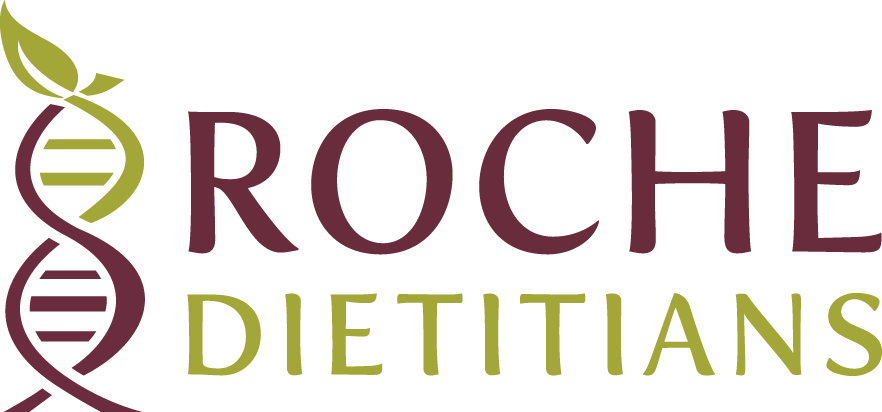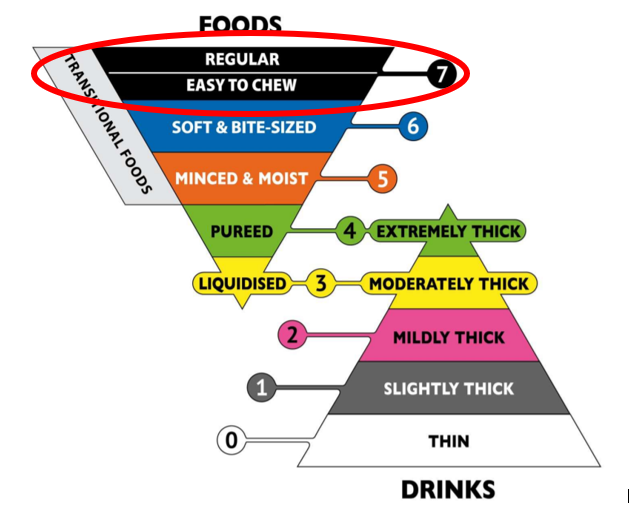Guide to IDDSI Regular Easy to Chew (Level 7)
You’re likely already serving regular foods, but what really defines the word “regular”? Without a standard definition, there is confusion, especially when receiving diet orders from other healthcare facilities. This puts individuals with dysphagia at a higher risk for choking.
The International Dysphagia Diet Standardization Initiative (IDDSI) Committee developed guidelines for serving texture modified foods and thickened liquids to individuals with dysphagia around the world. (Yes, around the world!) The initiative challenges us to prioritize safety and prevent the risk of choking, giving us a solution to the outdated, ambiguous language like “soft”, “chopped”, and “nectar-thick” that vary between every facility.
In order to eliminate confusion and promote patient safety, the new IDDSI standards establish unified principals for all foodservice operations to follow:
Consistent diet terminology
Standardized definitions of the diet
Simple, reliable testing methods
If you’re thinking IDDSI is a major endeavor -- you’re right. It means changes to recipes, menus, diet order transmissions, and training. It requires a coordinated, interdisciplinary effort among various departments. But it’s worth it to keep those we care for safe from choking.
We know that learning about IDDSI is a complex undertaking, and we’ve found that having a deep understanding of each IDDSI level is a good place to start. This post will walk you through IDDSI Regular Easy to Chew (Level 7) in detail, including:
Who is this level for?
How is this level characterized?
How do we test foods to fit within this level?
READ MORE: Your Ultimate Guide to IDDSI
Let’s start with the basics.
The basics of IDDSI Regular Easy to Chew (Level 7)
The IDDSI Framework consists of eight levels (Level 0-7), ranging from Thin Liquids (Level 0) to Regular (Level 7) texture foods. Each level has a unique name, color, and number to limit errors in prescribing, identifying, preparing, and assembling dysphagia diet orders.
In the graphic below, you can see where IDDSI Regular Easy to Chew (Level 7) is located within the IDDSI Framework.
As you can see, IDDSI Level 7 has two texture levels: IDDSI Regular and IDDSI Regular Easy to Chew. The only difference is that IDDSI Regular Easy to Chew has a specific food texture level (soft/tender). Although IDDSI Regular Easy to Chew (Level 7) has a separate name, it is still part of IDDSI Regular (Level 7). IDDSI Regular Easy to Chew is not a separate IDDSI texture level. IDDSI Regular Easy to Chew is the Regular Diet with changes to make it soft and easier to eat. From here on, we will be referring to the IDDSI Regular Easy to Chew as the IDDSI Easy to Chew.
Both IDDSI Easy to Chew (Level 7) and IDDSI Regular (Level 7) are represented by the number 7 and the color black. As with all other IDDSI food levels, it is shown within the downwards pointing triangle, while all IDDSI drink levels are represented with an upwards pointing triangle.
The abbreviation for IDDSI Easy to Chew (Level 7) is EC7, while the abbreviation for the IDDSI Regular (Level 7) is RG7. Your foodservice operation might use either of these abbreviations in many places, such as diet order communications, tray/service tickets, and in dining menu software or electronic health records.
Want to learn more about each IDDSI Level? See our post on IDDSI Pureed (Level 4)
Who IDDSI Easy to Chew (Level 7) is for
IDDSI Easy to Chew (Level 7) is suitable for individuals who may have some difficulty with chewing hard/firm textures but do not have dysphagia or problems with swallowing. This level does not restrict the size of food pieces, however modifies the texture of foods to allow soft/tender textures for easier chewing.
Even though these individuals do not have an increased risk of choking, they need softer foods because they struggle with hard or chewy foods due to age, fatigue, change in dental status, or other reasons.
This level is suitable for individuals who can bite and chew soft foods without tiring easily, but they may have pain when swallowing hard or chewy foods. Additionally, these individuals:
Can form a bolus of food in the mouth
Do not have an increased risk of choking
Are working toward advanced chewing skills
Because the size of food particles is not restricted at this level, IDDSI Easy to Chew (Level 7) is not appropriate for individuals with an identifiable choking risk or those who require supervision while eating.
As a side note: IDDSI Regular (Level 7) is suitable for individuals that do not have any problems with chewing or swallowing. Individuals on this level are served normal, everyday foods without any restrictions on size and texture.
Characteristics of IDDSI Easy to Chew (Level 7)
We’re used to thinking about food in terms of appearance, taste, smell, and temperature. IDDSI now introduces us to new and more specific characteristics like particle size, moisture, stickiness, and softness.
Although IDDSI Easy to Chew (Level 7) allows for regular, everyday foods, they still need to be soft and moist to accommodate the pain or discomfort individuals may experience while chewing. Thanks to IDDSI’s unified standards, foods on IDDSI Easy to Chew (Level 7) will maintain the same characteristics no matter where in the world you serve easy to chew foods. These characteristics include:
Normal, everyday foods of soft/tender textures
Omits foods with the following textures: hard, tough, chewy, sticky fibrous, stringy, crunchy, or crumbly bits, pips, seeds, fibrous parts of fruit, husks or bones
Particles of any size (no restrictions)
Can be eaten with a fork or spoon
May include dual or mixed-consistency foods, such as cereal or soup
Require biting and chewing of soft/tender foods before swallowing and without tiring easily; does not necessarily require teeth.
Example: EC7
Fish (prepared soft/tender without dry crisp, batter/coating and bones)
Want to learn more about each IDDSI Level? See our post on IDDSI Soft & Bite Size (Level 6)
Testing methods for IDDSI Easy to Chew (Level 7)
Testing is a new concept that shifts the way we do things in the kitchen. We know it’s not easy to make changes and get everyone on board but testing is worth it because it’s all about safety. Once it becomes part of our regular practice, it will only take a few extra seconds.
Testing IDDSI Easy to Chew (Level 7) requires only a fork and straightforward observation. These foods don’t have particle size restrictions, but they do need to be soft and tender enough to break apart easily with the side of a fork or spoon. We measure this using the Fork/Spoon Separation and Pressure Test:
Food cuts/breaks apart easily with the side of a fork (or spoon) or the texture can flake into smaller pieces
Food can easily squash, break apart, and change shape without returning to its original shape when applying pressure with a fork/spoon.
You may apply enough pressure with tines of a fork that the nail bed turns white
These tests are done during preparation and again at the time of service. It should be done under the same conditions we intend to serve our food, especially temperature. Remember, temperature and holding time will affect the consistency of food.
READ MORE: The five key components you need to train food service workers on IDDSI
Learning more about IDDSI Easy to Chew (Level 7)
IDDSI is an important tool in making sure that the food we serve is safe for individuals with chewing and swallowing problems. It’s vital that you and your team are well-versed in understanding IDDSI.
However, IDDSI can be complex to learn. That’s why we created the Roche Dietitians “We Test for Safety” IDDSI Training Program. This online, on-demand program will train your team on the new IDDSI standards in a straightforward, easy-to-understand way. From providing an overview of IDDSI with our Introduction Course to more comprehensive courses on each IDDSI level, including the IDDSI Easy to Chew (Level 7), your team will learn everything they need to know about the new IDDSI standards.
And the Roche Dietitians “We Test for Safety” IDDSI Training Program is not just about teaching your team about IDDSI — it empowers you to develop a culture of safety in your organization. Through this training, you will build a sustainable IDDSI culture where everyone knows their role in keeping your residents safe.






